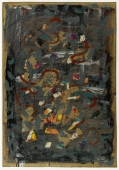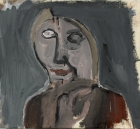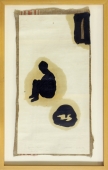
Artist | Twan Janssen (*1968)
https://www.artist-info.com/artist/Twan-Janssen
Biography
Biography
Born 1968, Milsbeek (The Netherlands)
1987 - 1991 Hogeschool voor de Kunsten, Arnhem
1991 - 1992 Ateliers Arnhem
About the work
About the work
Dare to look the other way!
By Sue Spaid
Typically, paintings comfortably repose on walls. We either view them involuntarily out of the corner of our eye (peripheral vision)or we volutarily cast our gaze forward in face-to-face communion.These days, people tend to glorify the unwillful submission to art's attention-getting schemes (i.e. all this viewerbabble about 'wanting/needing to be seduced'), in hopes of achieving some romantic ideal of total abandonment. Since it's hard to imagine that a painting would intercept our focus if our back were turned on it, conventional wisdom dictates just look the other way if you're unavailable to play with paintings' ploys. Conventional wisdom naively sides with selfcontrol. but how can we deliberately deflect our gaze when what's art (the art-part) isn't so visibly obvious?
Contrarily, the lure of an accidental glance, given one's unwillful sub mission, seems tantamount to some sort of unlawful violation, i.e. the rape of the eye. Twan Janssen's idiosyncratic paintings hardly solicit unwillful submission, and they' re too disarming to require deflection, yet their elusiveness elicits our attention and inspires us to delight in painting's endless possibilities.
Perhaps viewing tantalizing art (tart-art) is always involuntary, which is why we become more vulnerable with each incidental sighting. until we drop from exhaustion. Passively swallowing eye candy enervates, while actively discovering hidden rewards rejuvenates. Nonetheless, painting's capacity to capture and ensnare momentarily is more exemplary of its flirtatious prowess than its prospect as a coy seducer. Seduction temporarily secures the artist against the risk of willful neglect and rejection. Strong art chalenges the viewer with a double-Dutch dare -'I dare you to ignore or admire me, to cherish or dismiss me, to question my artfulness..-'The truly ugly must always seduce, while the beautiful dares to be just itself no more and no less. Contrary to John Keats' famous dictum relating truth and beauty, only the ugly need the kind of truth that demands conformity to Tact or fidelity to a standard. Beauty doesn't need truth. Truth is fiction masquerading as reality.
Daren't Be A Painting!
Twan Janssen's room-size groupings of tactile paintings render conventional wisdom obsolete. as Janssen situates each viewer amidst each painting's sprawling frame. Such spacious paintings' minute gestural details necessitate active viewing. We must look up and over, below and under, and mostly around and around, lest we relinquish the pleasure of wonder ( the ecstatic state of experiencing something quite unexpected). Even with our back to his works something sight unseen still beckons our attention. For if you're not actively looking, which also has an involuntary or accidental aspect. you will voluntarily overlook the variety of painting experiments that Janssen's eager curiosity has pushed him to explore. Even the shelfpaintings, which are wall mounted like a typical painting, reveal so little of each paint sheet folded and stacked on the shelf that the viewer must scrutinize the folded edges in order to ascertain the myriad patterns and color combinations that heighten their magical mystery.
The numerous innovative techniques that comprise Janssen's most recent projects attest to his total love for paint's material (physical) qualities-color's wide range of emotional content, the fluidity of liquid paint squirting straight from the tube (pure ooze, pure glory) the vitality and vulnerability of the freshly dripped treacle dangling from a wire support, and the maneuverabilty of the lusciously painted brass tube on steel wire. Earlier shelf pieces (1992's 'FRONT' installation at Amsterdam's W139) revealed intimate spills and splotches on small notched or sub-divided vacuum-formed shelves. Minuscule anthropomorphic bundles of twisted paint twirled above sheets of pristine linen (1993's 'Pure Paint II' at Utrecht's CASCO). The 'Toy Monochromes' from 1994 resembled balls of string, but were formed by mounds of paint squirts. One can't help but recall highschool lessons such as: a line comprises an infinite number of points (Geometry), gravity's force Is constant (Physics), and a temperature decrease or a pressure increase will make a liquid solid (Chemistry) when one observes the natural dangle and sway of treacle.
Most of Janssen's mark-making moves evoke cake-decorating techniques, but the careful viewer will realize that nothing is decorated. The relationship between painting and frosting is currently de rigueur. Rudolf Stingel's photo-documentation of 'How to make a Painting' from the mid-80's prominently featured a mixer and specialty trowels. Many contemporary artists have presented elaborately decorated cakes as their art (Pat Lasch, Sandy Habsmann) and several painters use frosting techniques to paint (Lari Pittman, Linda Burnham, Randy Wray, Dennis Hollingsworth, Doug Hammet), but only Janssen uses so-called decorating techniques to make things that are ends in themselves. Typical of art, they are excessive, useless and extravagant, but unlike decorated objects (cakes and canvasses), his paint blobs resist gravity's pull, because they eschew attachment and preciousness (for the most part). By liberating the singular material responsible for painted painting, he disassociates his project from our memories of painting encounters. As a result, our personal experiences with his things engender novel memories which makes them seem doubly special.
Dare To Find A Way To Re-Paint!
One can't ignore his interest in:
- casting paint (flat or textured paint sheets on shelfs, curtain-like paints sheets hugging a wall or cylindrical paint forms squeezed through a paint-tube's nozzle).
- cast offs (forgettable things set free) and
- casting theatrical roles (art and life as inspirations for theatre plays).
Nothing gets thrown away in his process. Everything is recoupable, as long as paint's aplenty.
His 1993 performance 'White Lily' involved whiting-out an already existent Lily van der Stokker floral mural with wallpaint. Janssen has even constructed domestic throw rugs from dots of paint meshed closely together, which dry as a solid mass. He has made seemingly woven paintings by repeating paint strokes in the shape of an X until a web forms. His signature ready-made is another web-shape, an insta-installation of cobwebs strewn from an aerosol can. Even when he uses photographs, he first retouches them with paint. Most of his cast paint sheets get folded neatly or scrunched up into gnarly paint wads that resemble scattered gift wrap paraphernalia (1995's 'Twan Janssen featuring Zwandel' at Nova Zembla and 1996's 'Bored stiff, spoilt rotten II' at Stockholm's Gallery TRE). The tattered theater-inspired curtains drape in then venerable fullness as totally sumptious sheet of unadulterated paint (1995 'Par Avion' at Los Angeles' L.A.C.E.). Shed no tears, not to care, if it tears. Patches of grafted curtain trimmings can repair the tears. Surprisingly, the paintsuff recombines into something more magical than its first incarnation. The retouched photos of rayguns (1994's biennial at the Arnhem Municipal Museum) resurfaced in 1996 amidst a paint-pile in Stockholm and the fogmachine gets dragged out at least once a year.
Who knows where it will turn up next? One curator saved the disas trous remnants of a bubble-gum pink curtain he had instructed her to make. Fifteen months later he hid the paint wad in a mostly white installation (1996's 'Death is a career move' at Los Angeles' LASCA Gallery). 1996's 'My Eye-Level' (a rotating laser beam) is ripe for reap pearance. To re-use or re-paint is to foster viewer recollection. What's next? To be honest, I'm super excited by what's on the horizon. The idea of theater as retouchable paint is still in development and played a central role in his recent exhibit 'FOLLY' at Amsterdam's Stedelijk Museum Bureau Amsterdam.'Solo, A theatre play in four acts' makes its Los Angeles debut at Los Angeles' Cirrus Gallery this summer. The 'Studies for all tomorrow's parties I & II' (1997), dazzling, multicolored looping ribbons of paint, totally pique my interest and frankly, I can't wait to see them realized.
Text by: Sue Spaid, Los Angeles-based independent writer and critic
Solo Exhibitions
Solo Exhibitions
1992 FRONT, W139, Amsterdam
1993 Pure Paint II, Casco, Utrecht
1994 General Merchandise, Municipal Museum, Helmond (cat.)
1994 Installation, Associated Publishers, Amsterdam
1995 Twan Janssen featuring Zwändel, Nova Zembla, Den Bosch
1996 Bored stiff, Spoilt rotten, Galleri TRE, Stockholm
1996 I DON'T DANCE, Galerie van Gelder, Amsterdam
1996 Solo, een toneelstuk in vier bedrijven, Museum voor Moderne Kunst, Arnhem
1996 'If you want chocolate, why are you eating vegetables?', W139, Amsterdam (with Terri Friedman)
1996 Death is a career move, LASCA Gallery, Los Angeles
1997 'FOLLY', Stedelijk Museum Bureau Amsterdam
1997 Modern times are modern anyway, Bliss, Los Angeles
Group Exhibitions (selection)
Group Exhibitions (selection)
1991 Le Vent du Nord VII, Institut Néerlandais, Parijs (cat.)
1992 Atelier Sömmering, Keulen
1992 Quantität statt Qualität, Ehrenfelder Kunstkreis, Keulen
1993 De aanraking, de huid, Stelling Gallery, Leiden (cat.)
1994 Art Hotel '94, Hilton Hotel, Amsterdam (Galerie van Gelder)
1994 Tekeningen & tekeningen, Galerie van Gelder, Amsterdam
1994 Werk aan de wand, op de vloer en aan het plafond, Galerie van Gelder, Amsterdam (with Jaap Kroneman)
1994 Biënnale Gelderland '94, Gemeentemuseum Arnhem (cat.)
1994 Videotapes, Casco, Utrecht
1995 New Age Da Da, GEWAB Gebouw Arnhem
1995 Twan Janssen & Gerard Kodde, Konstakuten Roslagsstull, Stockholm
1995 Negen kanten, Galerie van Gelder, Amsterdam
1995 New Age III (echt zijn, alles geven / being real, giving it all), Kunstcentrum Begane Grond, Utrecht
1995 Shaking Patterns, W139, Amsterdam
1995 Comp i box, Galerie van Gelder, Amsterdam (curator: Twan Janssen)
1995 Par avion, Los Angeles Contemporary Exhibitions, Los Angeles (curator: Sue Spaid)
1996 Unidentified Objects, Hooghuis, Arnhem
1996 Brethouwer, Goudzwaard, Janssen, Lokaal 01, Antwerpen
1996 The Unbearable Whiteness of Skiing (existentialism now), Het Hooghuis, Arnhem (curator: Twan Janssen)
1996 CHALK: a temporary chill out room, Factory Place Gallery, Los Angeles (curator: Sue Spaid)
1996 Review II, Galerie TRE, Stockholm Star Projects, Vrieshuis Amerika, Amsterdam (curator: Jan van der Ploeg)
1996 New Age Da Da, Kunstraum Berlin, Berlin
1996 Heb ik wat van je aan soms?, Begane Grond Kunstcentrum Utrecht, Utrecht
1997 Blå, Gul, Röd (Blue, Yellow, Red), Södertalje konsthall, Södertalje Sweden (cat.)
1997 De verbouwing, de verhuizing & de verandering, Galerie van Gelder, Amsterdam
1997 Working out the Kinks, Künstlerhaus Bethanien, Berlijn (curator: Sue Spaid)
1997 The People's Choice, Kunsthal, Rotterdam
1997 Diskland/Snowscape, Shed im Eisenwerk, Frauenfeld (SW) (curator: Harm Lux)
1997 Random Access Memory, Cirrus Gallery, Los Angeles (curators: Sue Spaid & Twan Janssen)
1997 Radicaal-beeld, Stedelijk Museum, Schiedam
 offers / Requests offers / Requests  |
About this service |
|---|
 Exhibition Announcements Exhibition Announcements  |
About this service |
|---|
 Visualization |
Learn more about this service | ||
|---|---|---|---|

Interested in discovering more of this artist's networks?
3 easy steps: Register, buy a package for a visualization, select the artist.
See examples how visualization looks like for an artist, a curator, or an exhibition place: Gallery, museum, non-profit place, or collector.

Exhibition History

|
SUMMARY based on artist-info records. More details and Visualizing Art Networks on demand. Venue types: Gallery / Museum / Non-Profit / Collector |
||||||||||||
| Exhibitions in artist-info | 10 (S 5/ G 5) |
Did show together with - Top 5 of 16 artists (no. of shows) - all shows - Top 100
|
||||||||||
| Exhibitions by type | 10: 9 / 1 / 0 / 0 | |||||||||||
| Venues by type | 6: 5 / 1 / 0 / 0 | |||||||||||
| Curators | 0 | |||||||||||
| artist-info records | Apr 1996 - May 2002 | |||||||||||
|
Countries - Top 3 of 3 Netherlands (8) Sweden (1) United Kingdom (1) |
Cities 3 - Top of 3 Amsterdam (8) Stockholm (1) London (1) |
Venues (no. of shows )
Top 5 of 6
|
||||||||||
|
Curators (no. of shows)
Top 0 of 0 |
| Nylon | G | Apr 2002 - May 2002 | London | (23) | +0 | |
| Galerie van Gelder | S | Sep 2001 - Oct 2001 | Amsterdam | (33) | +0 | |
| Galleri Flach | S | Jan 2000 - Mar 2000 | Stockholm | (10) | +0 | |
| Another Place | S | Sep 1998 - Oct 1998 | Amsterdam | (8) | +0 | |
| Another Place | S | Jun 1998 - Jul 1998 | Amsterdam | (8) | +0 | |
| Galerie van Gelder | G | Jan 1998 - Feb 1998 | Amsterdam | (33) | +0 | |
| Keep reading |









































